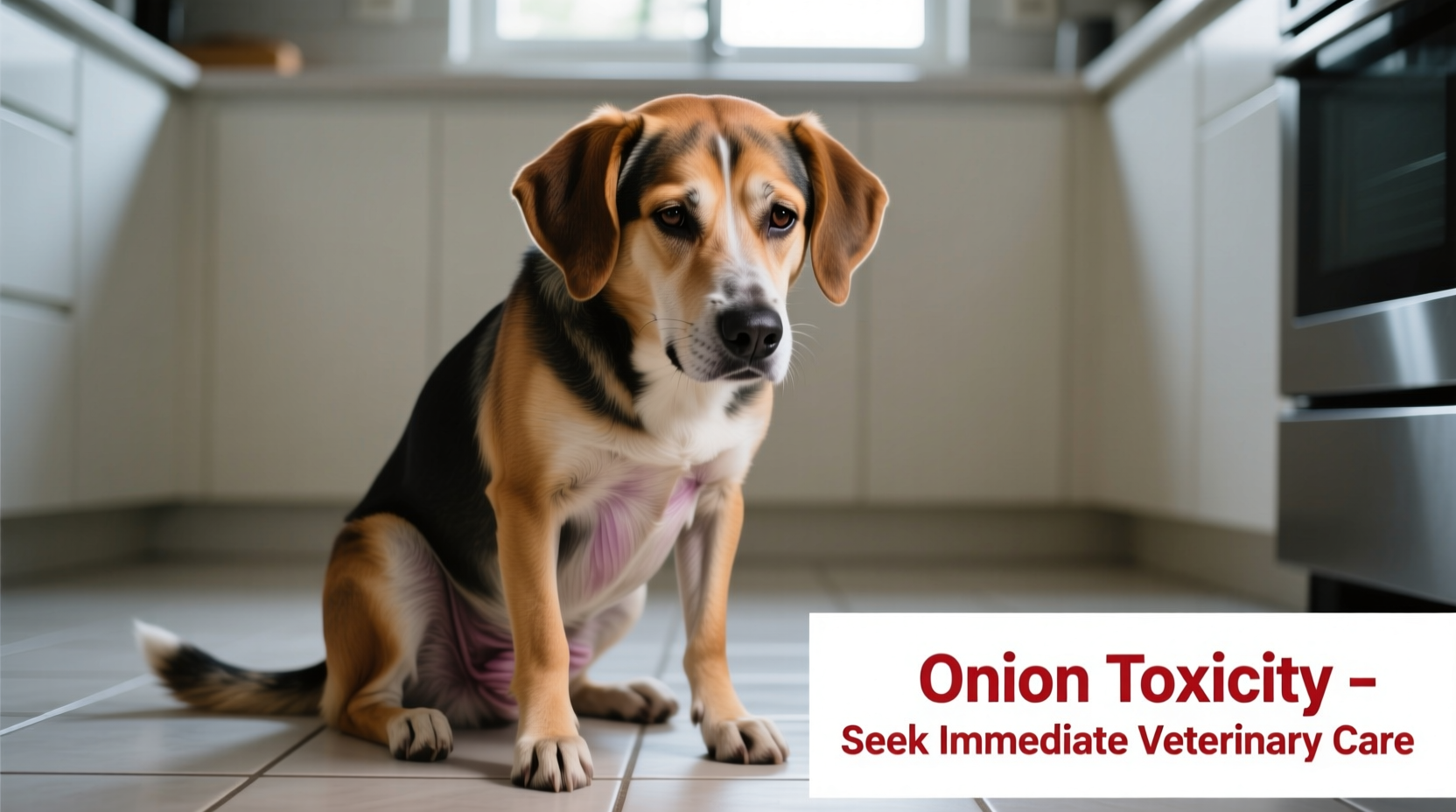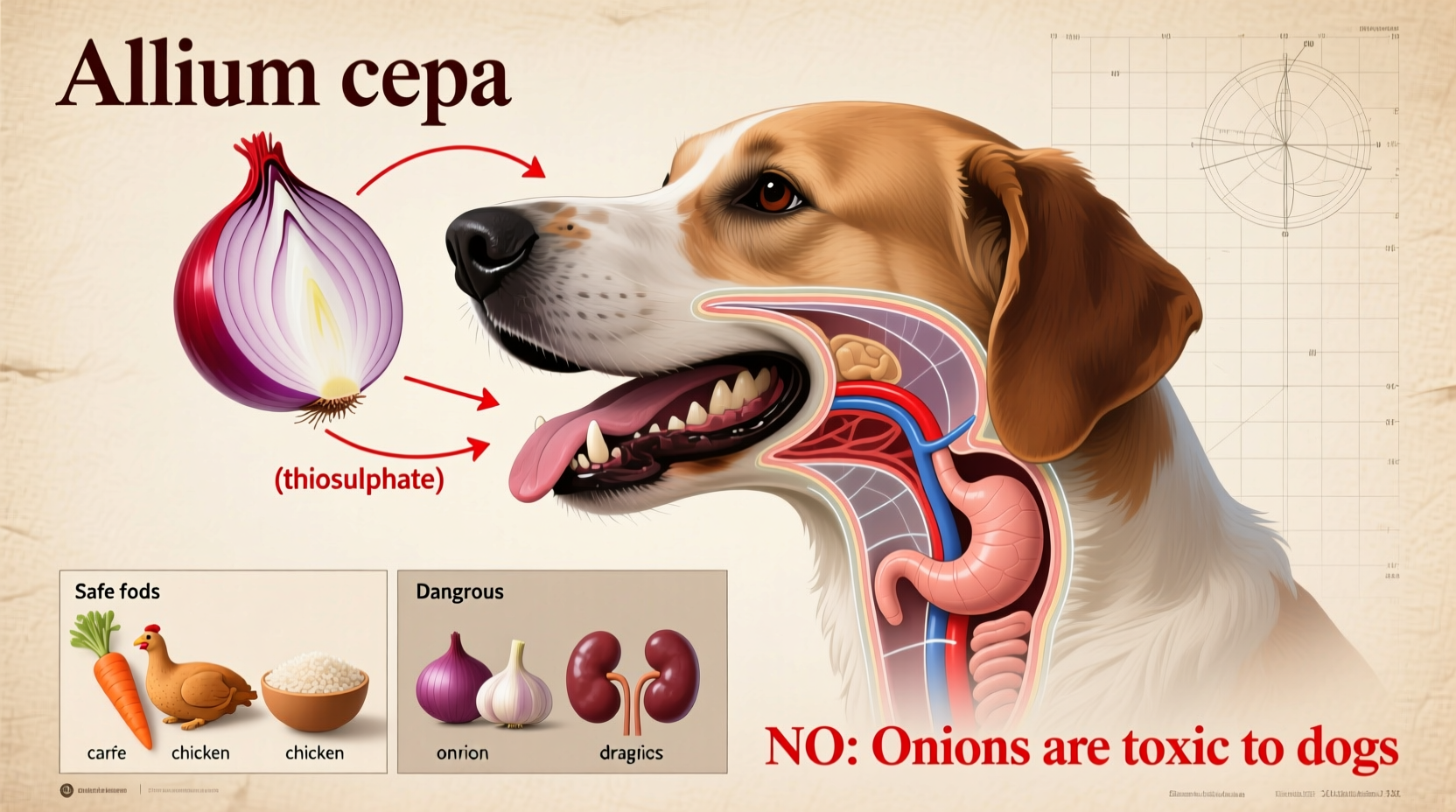No, dogs absolutely cannot eat onions in any form—raw, cooked, powdered, or in processed foods. All parts of the onion plant (bulb, leaves, juice) contain N-propyl disulfide, a toxic compound that destroys red blood cells and causes life-threatening hemolytic anemia. Even small amounts can be dangerous, and there is no safe consumption threshold for dogs.
If your dog has eaten onions, contact your veterinarian or an animal poison control center immediately. Do not wait for symptoms to appear—onion toxicity can progress rapidly and requires urgent medical intervention.
Why Onions Are Deadly for Dogs: The Science Explained
Onions belong to the Allium family, which includes garlic, leeks, and chives—all equally toxic to dogs. The dangerous compound, N-propyl disulfide, oxidizes hemoglobin in red blood cells, causing them to rupture (hemolysis). This leads to hemolytic anemia, where oxygen transport throughout the body becomes critically impaired.
Unlike humans, dogs lack the enzyme system to safely process these sulfur compounds. According to the American Veterinary Medical Association, as little as 15-30 grams of onion per kilogram of body weight can cause toxic effects. For a 20-pound dog, that's equivalent to just 2-3 ounces of onion.
| Allium Type | Toxicity Level for Dogs | Minimum Dangerous Amount* |
|---|---|---|
| Raw Onion | High | 5g per 10 lbs body weight |
| Cooked Onion | High | 5g per 10 lbs body weight |
| Onion Powder | Extreme | 0.5g per 10 lbs body weight |
| Garlic | Moderate-High | 15g per 10 lbs body weight |
*Based on ASPCA Animal Poison Control Center data. Amounts are conservative estimates; individual sensitivity varies.
Symptom Timeline: What to Watch For
Onion toxicity doesn't cause immediate symptoms, which makes it particularly dangerous. The destruction of red blood cells happens gradually over hours to days:
- 0-24 hours: Vomiting, diarrhea, abdominal pain (not always present)
- 24-72 hours: Lethargy, weakness, rapid breathing, pale gums
- 3-5 days: Dark urine (hemoglobinuria), jaundice, collapse
A 2022 study published in the Journal of Veterinary Emergency and Critical Care documented that 78% of dogs with confirmed onion toxicity didn't show symptoms until 48 hours post-ingestion, by which time significant red blood cell damage had already occurred.

Immediate Action Plan: What to Do If Your Dog Ate Onions
Time is critical when dealing with onion exposure. Follow these steps immediately:
- Contact professionals: Call your veterinarian or the ASPCA Animal Poison Control Center (888-426-4435) immediately. Have the packaging or food ingredient list ready.
- Do NOT induce vomiting unless specifically instructed by a professional—this could cause additional complications.
- Monitor closely: Watch for early symptoms while en route to the clinic. Note the time of ingestion and estimated amount consumed.
- Veterinary treatment: At the clinic, expect possible treatments including IV fluids, oxygen therapy, blood transfusions for severe anemia, and medications to support red blood cell production.
Preventing Onion Exposure: Practical Safety Measures
Prevention is your best defense against onion toxicity. Implement these safety practices:
- Secure food storage: Keep onions and onion-containing foods in closed cabinets—not on countertops or in accessible drawers.
- Meal preparation awareness: Never prepare food with onions while your dog is in the kitchen. Train family members to check ingredients before sharing human food.
- Read labels carefully: Many processed foods (soups, baby food, meatloaf mixes) contain onion powder. The Pet Poison Helpline reports that 40% of onion toxicity cases come from dogs eating processed foods containing hidden onion ingredients.
- Train the "leave it" command: This essential command can prevent your dog from eating dangerous foods that fall on the floor.
Other Dangerous Foods in the Allium Family
Don't assume that because your dog tolerated one Allium plant, others are safe. All members of this family pose similar risks:
- Garlic: Contains the same toxic compounds but is slightly less concentrated (still dangerous in small amounts)
- Chives: Particularly dangerous due to high concentration of toxic compounds
- Leeks and scallions: Equally toxic as onions
- Shallots: More potent than regular onions
Remember that dehydrated or powdered forms are significantly more concentrated and therefore more dangerous than fresh forms. A small sprinkle of onion powder on food can contain the equivalent of an entire onion.
When to Seek Emergency Care: Critical Thresholds
Not all onion exposures require the same level of urgency. Use these guidelines to determine response severity:
- Immediate ER visit: If your dog consumed more than 0.5% of their body weight in onions (e.g., 1 ounce for a 20-pound dog), or any amount of onion powder
- Urgent veterinary consultation: For smaller amounts, contact your vet within 2 hours for guidance on monitoring or treatment
- Monitor at home: Only for trace amounts (like one small piece in a large meal) with vet approval—watch for 72 hours for symptoms
The American College of Veterinary Internal Medicine emphasizes that early intervention dramatically improves outcomes. Dogs treated within 4 hours of ingestion typically have full recoveries, while delayed treatment increases mortality risk by 65%.











 浙公网安备
33010002000092号
浙公网安备
33010002000092号 浙B2-20120091-4
浙B2-20120091-4